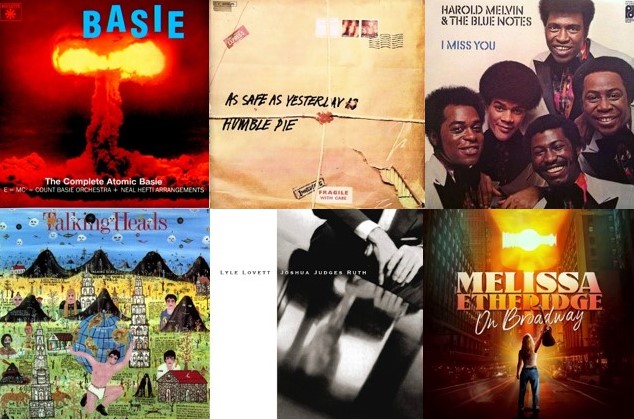It’s Sunday and hard to believe another week has flown by. On the upside, this means the time has come again to embark on a little imaginary music time travel excursion. As always, the itinerary includes six stops in six different decades with music in different flavors.
Lester Young/I Can’t Get Started
This first pick, which takes us back to 1956, was inspired by fellow blogger and jazz connoisseur Cincinnati Babyhead, aka. CB, who the other reminded me of Lester Young. Nicknamed The President, the tenor saxophonist and occasional clarinetist was active between 1933 and 1959. Young first gained prominence as a member of Count Basie’s orchestra. I Can’t Get Started, initially a 1936 composition by Vernon Duke with lyrics by Ira Gershwin, was included on Young’s 1956 album The President Plays With the Oscar Peterson Trio. This smooth music is perfect to ease us into the trip!
Ramones/Blitzkrieg Bop
Hey! Ho! Let’s go! To April 1976, which saw the eponymous debut album by New York punk rockers Ramones. They had formed two years earlier in the Queens neighborhood of Forest Hills. The band originally featured lead vocalist Jeffrey Hyman (Joey Ramone), guitarist and backing vocalist John Cummings (Johnny Ramone), bassist and backing vocalist Douglas Colvin (Dee Dee Ramone) and drummer Thomas Erdelyi (Tommy Ramone). Blitzkrieg Bop, co-written by Tommy and Dee Dee, was the band’s debut single. This fun music is my kind of punk rock. One, two, three, four!
Gary Moore/Story of the Blues
Time for some blistering electric blues with a nice soul touch by Gary Moore. Prior to releasing his solo debut Back on the Streets in 1978, the Northern Irish guitarist played with Irish bands Skid Row and Thin Lizzy. By the time he released his ninth solo album After Hours in March 1992, Moore had comfortably settled on blues and blues rock, which remained his main musical focus until his untimely death from a heart attack at age 58 in February 2011. Here’s Story of the Blues, a song he wrote.
Gregg Allman/Black Muddy River
Our next stop takes us down south and to the present century. In March 2016, Gregg Allman recorded what would become his final album Southern Blood. Initially, the Allman Brothers co-founder had planned a sequel to his 2011 solo album Low Country Blues with original songs. But Allman who had been diagnosed with liver cancer in 2012 was running short of time, so he worked with his manager Michael Lehman to pick “meaningful” songs to cover. Southern Blood was recorded over just nine days at FAME Studios in Muscle Shoals, Ala. The album was released in September 2017, four months after his death. Speaking of the Allmans, on Thursday, Dickey Betts passed away from cancer and COPD, leaving drummer Jaimoe (John Lee Johnson) as the former group’s only surviving co-founding member. Here’s Allman’s incredible rendition of the Grateful Dead’s Black Muddy River, co-written by Jerry Garcia and Robert Hunter.
The Hollies/Bus Stop
I always get weirdly emotional when listening to music from Southern Blood, so my next proposition is more upbeat. Enter a catchy ’60s song with sweet harmony vocals: Bus Stop by The Hollies. Initially formed in the late ’50s as duo comprised of Allan Clarke (vocals, guitar) and Graham Nash (vocals, guitar), they became The Hollies in December 1962, together with Vic Steele (lead guitar), Eric Haydock (bass) and Don Rathbone (drums). Bus Stop, released in June 1966 and penned by future 10cc member Graham Gouldman, was one of the group’s biggest hit singles and was also the title track of their fourth U.S. album. The Hollies exist to this day as a touring act and most recently were on the road in the UK last year. Tony Hicks and Bobby Elliott, who played guitar and drums, respectively, on Bus Stop, are part of the current line-up.
Scorpions/Bad Boys Running Wild
And just as this trip is in full swing, we need to wrap up again. Let’s push the pedal to the metal with Scorpions and the great opener of March 1984’s Love at First Sting. The German metal band’s ninth studio album cemented their status as an internationally popular act. With approximately 3.5 million sold units worldwide, Love at First Sting became their second-highest seller after Crazy World (November 1990). Initially were formed in 1965, Scorpiona continue to rock on and are currently on the road. Here’s Bad Boys Running Wild, with music composed by guitarist and co-founder Rudolf Schenker and lyrics written by lead vocalist Klaus Meine and then-drummer Herman Rarebell.
Of course, I wouldn’t leave you without a Spotify playlist of the above track. Hope sometimes tickles your fancy and that you’ll be back for more!
Sources: Wikipedia; YouTube; Spotify










